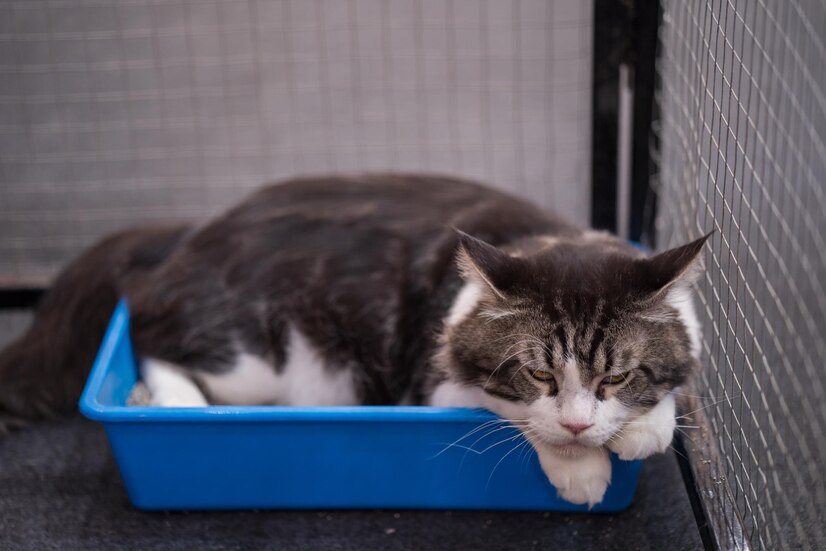Are litter box troubles stressing you out? Many pet owners make simple mistakes that frustrate both them and their cats. Cats are naturally clean, with specific preferences that, if ignored, can lead to accidents and behavior issues. With a few adjustments in placement, cleanliness, and setup, you can keep your home fresh and your cat content. Let’s explore the most common litter box mistakes to avoid, helping you create a cleaner, happier space for both of you.
Read How to Stop Your Cat from Peeing Outside the Litter Box
8 Litter Box Mistakes to Avoid
Keep reading to avoid all litter box-related mistakes.
1. Choosing the Wrong Size or Type of Litter Box
One of the most overlooked aspects of a litter box setup is selecting the right box. The size and type can significantly influence whether or not your cat uses it. Read Can Cats Eat Cheese?
Mistake: Box Too Small or Too Big
- Why It’s a Problem: Cats need space to move around, dig, and cover their waste. A box that’s too small can make them feel cramped, causing them to avoid it. Similarly, a very large box can feel uncomfortable, especially for kittens or smaller cats.
- Solution: Choose a box that’s at least 1.5 times the length of your cat. For larger breeds, consider an extra-large litter box to accommodate their size. Read Why Do Cats Kick Litter Everywhere?
Mistake: Covered Boxes Without Considering Your Cat’s Preference
- Why It’s a Problem: Covered boxes trap odors, which may seem helpful, but can actually repel cats. Some cats also feel trapped in enclosed boxes, causing stress and avoidance.
- Solution: Test both open and covered boxes. If you use a covered box, ensure it has proper ventilation and is cleaned frequently. Read Kidney Disease in Cats: Early Signs You Shouldn’t Ignore
2. Not Enough Litter Boxes for Multiple Cats
Sharing is often not in a cat’s nature, especially when it comes to their litter box.
Mistake: Having Fewer Boxes Than Needed
- Why It’s a Problem: Cats are territorial and don’t always like to share. In multi-cat households, having just one box can lead to fights, territorial marking, or inappropriate elimination.
- Solution: The general rule is one box per cat, plus one extra. This setup helps reduce competition and ensures that each cat feels they have their own space. Read How To Clean a Litter Box Step by Step
Placement Tip
Make sure each box is placed in a separate, quiet area, as clustering them in one room can feel like a single shared box to your cats.
3. Placing the Litter Box in Uncomfortable or Noisy Locations
Cats prefer calm, private spaces to do their business, much like we do.
Mistake: High-Traffic or Loud Areas
- Why It’s a Problem: Placing a litter box in a busy or loud area can make cats feel unsafe. Loud sounds, like those from laundry machines or heating systems, may scare them away.
- Solution: Locate the litter box in a quiet, low-traffic area where your cat can use it undisturbed. If you have a multi-level home, consider placing boxes on different floors to avoid long trips.
Mistake: Confusing Locations
Avoid placing the box in a location that’s hard for your cat to reach, like behind a closed door or in a tight space, which can make it inconvenient for them. Read How to Train Your Cat to Use the Litter Box
4. Neglecting Cleanliness – Cats Need a Clean Environment
Cats are incredibly particular about cleanliness, and they won’t use a dirty litter box.
Mistake: Not Scooping Daily
- Why It’s a Problem: Cats have a strong sense of smell, and a dirty box can be highly unappealing. Failing to scoop daily increases odors, making the box undesirable.
- Solution: Scoop the litter box at least once a day. For households with multiple cats, scooping more frequently is often necessary to keep the box fresh and inviting. Read Can Cats Eat Onions? A Deadly Threat
Mistake: Not Doing a Full Clean Regularly
- Why It’s a Problem: While daily scooping is essential, residual waste and odor can build up over time, even in clumping litter.
- Solution: Empty and thoroughly clean the box at least once every 2–4 weeks. Use mild soap and water, avoiding harsh chemicals like bleach that could deter your cat from using the box due to lingering scents.
Expert Tip: For more in-depth cleaning recommendations, visit FuzzyTumz on maintaining a fresh litter box (FuzzyTumz).
5. Using Scented Litter or Harsh Chemicals
Many owners choose scented litter thinking it will mask unpleasant odors, but cats often find strong scents off-putting.
Mistake: Using Strongly Scented Litter
- Why It’s a Problem: Cats have an acute sense of smell, and scented litters can be overwhelming, deterring them from using the box.
- Solution: Choose unscented litter, preferably one with a sand-like texture that most cats prefer. If odor is a concern, focus on regular cleaning rather than masking the smell with scents.
Mistake: Using Strong Chemicals to Clean the Box
Harsh chemicals like bleach can repel cats. Instead, stick to mild soap and warm water to avoid leaving behind a strong odor that may deter your cat. Read Why Is My Cat Peeing Outside the Litter Box?
6. Changing Litter Types Too Abruptly
Cats are creatures of habit and prefer consistency, even in their litter.
Mistake: Switching Litter Abruptly
- Why It’s a Problem: A sudden change in litter type or brand can cause stress, and your cat may refuse to use the new litter.
- Solution: If you need to change the litter, do so gradually. Mix a small amount of the new litter with the old, slowly increasing the proportion over several days to help your cat adjust.
7. Ignoring Signs of Discomfort or Health Issues
Inconsistent litter box use can often signal underlying health issues. Ignoring these signs can lead to long-term problems.
Mistake: Assuming It’s Behavioral
- Why It’s a Problem: Cats often avoid the litter box due to health issues, such as urinary tract infections (UTIs), arthritis, or digestive problems. Behavioral issues are not always the cause. Read Can Cats Eat Bananas?
- Solution: If your cat suddenly starts avoiding the box, consult your veterinarian to rule out health concerns. PetMD offers a great guide on recognizing health-related litter box avoidance (PetMD).
8. Using the Wrong Amount of Litter
How much litter you add to the box can significantly impact whether your cat feels comfortable.
Mistake: Adding Too Much or Too Little Litter
- Why It’s a Problem: Cats like to dig and cover their waste. Too much litter makes this difficult, while too little can expose the bottom of the box, making it uncomfortable for them.
- Solution: Aim for 2–3 inches of litter depth. Adjust based on your cat’s preferences, as some may prefer slightly more or less. Read Why Is My Cat Pooping Outside the Litter Box?
FAQ Section
Where should I avoid placing the litter box?
Avoid high-traffic or noisy areas. Cats need privacy and may avoid a box in a busy spot.
Is scented litter a mistake?
Yes, scented litter can deter cats. Stick to unscented for a more appealing option.
Are covered litter boxes problematic?
They can be. Some cats feel trapped, and covers trap odors. An open box may work better.
Read Also
Why Does My Cat Follow Me Everywhere?



